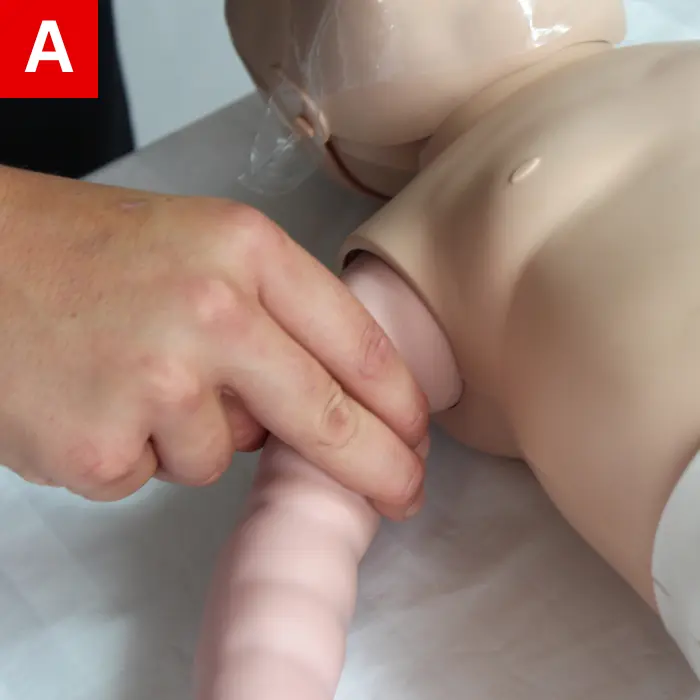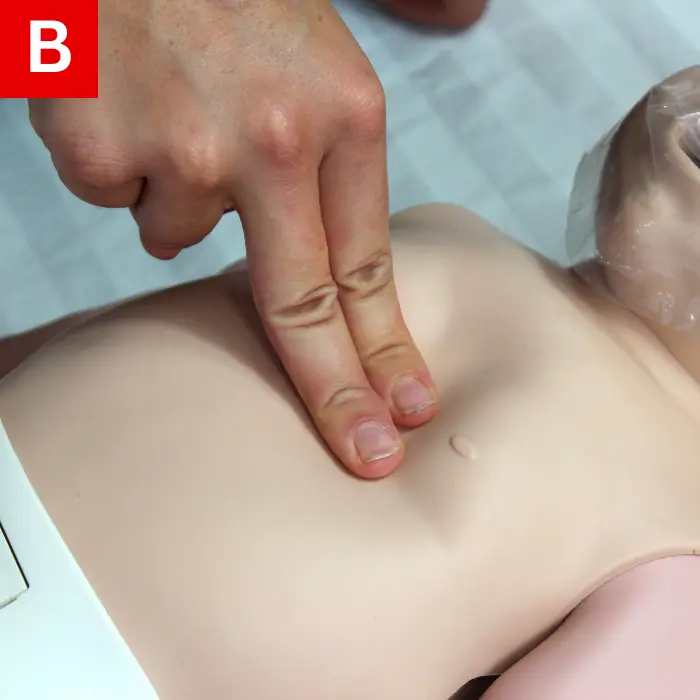BLS for Infants (0 – 12 months)

Figure 2
BLS for children and infants is nearly the same. For example, if two individuals are ready to perform CPR on-site, the breath to compression ratio is 15:2 for both children and infants. The main differences between BLS for children and infants are: (Table 2 previous lesson):
- The pulse of the infant is located through the brachial artery, found on the inside of upper arm between the infant’s elbow and shoulder.
- When executing CPR, compressions can be done with two fingers (with one rescuer) or two-thumb encircling hands (if there are two rescuers and one of their hands is big enough to perform this) (Figure 2).
- One third of the chest is the recommended compression depth, which is usually about 1.5 inches (4 cm) for most infants.
- Cardiac arrests are uncommon among infants and are usually a complication brought about by respiratory problems. The infant’s survival rate improves when the respiratory complication is readily solved. Remember that prevention is the first step in the Pediatric Chain of Survival.
One-Rescuer BLS for Infants
As the sole rescuer at the scene of an emergency, make sure to take the following actions:
- Engage with the infant by talking loudly or tapping their shoulder to assess the patient’s responsiveness
- If the infant isn’t responding and not breathing (or if they are only gasping), yell for help. If someone responds, send the second person to call EMS and to get an AED.
- Assess if they are breathing while feeling for the infant’s femoral or brachial pulse for no more than 10 seconds (Figure 3a).
- If you are unable to find a pulse (or if you are unsure), begin CPR by doing 30 compressions followed by two breaths. If you do feel a pulse but the rate is less than 60 beats per minute, begin CPR. This rate is too slow for an infant. To perform CPR on an infant do the following (Figure 3b):
- Be sure the infant is face-up on a hard surface.
- Using two fingers, perform compressions in the center of the infant’s chest; do not press on the end of the sternum as this can cause injury to the infant.
- Compression depth should be about 1.5 inches (4 cm) and a rate of 100 to 120 per minute.
- For about two minutes, execute CPR operations of about 30 compressions and two breaths for five cycles. If help has yet to arrive, call 911/EMS and secure an AED. (The ILCOR points to the universality of speakerphone function in mobile phones, allowing rescuers simultaneously attend to the infant while calling for help).
- Follow the instruction on the AED while executing CPR until EMS arrives or until the child recuperates into a more stable condition.


Figure 3
Two-Rescuer BLS for Infants
If you are with a second rescuer with the infant, do the following:
- Engage with the infant by talking loudly or tapping the bottom of their foot to assess the patient’s responsiveness.
- If the infant isn’t responding and not breathing (or is only gasping), send the second rescuer to call 911 and get an AED.
- Assess if they are breathing while feeling for the infant’s brachial pulse for no more than 10 seconds.
- If you cannot feel a pulse (or if you are unsure), begin CPR by doing 15 compressions followed by two breaths. If you can feel a pulse but the rate is less than 60 beats per minute, begin CPR. This rate is too slow for an infant.
- Begin CPR by performing 15 compressions by one rescuer and two breaths by the second rescuer, when the second rescuer returns. If the second rescuer can fit their hands around the infant’s chest, perform CPR using the two thumb-encircling hands method. Do not press on the bottom end of the sternum as this can cause injury to the infant.
- Compressions should be approximately 1.5 inches (4 cm) deep and at a rate of 100 to 120 per minute.
- Use and make sure to follow the prompts from the AED when available. Continue CPR until EMS arrives or until the infant’s condition normalizes.
